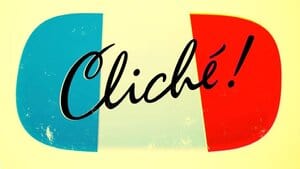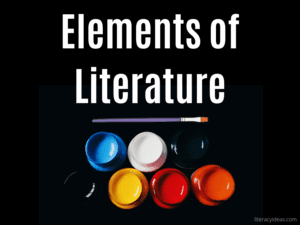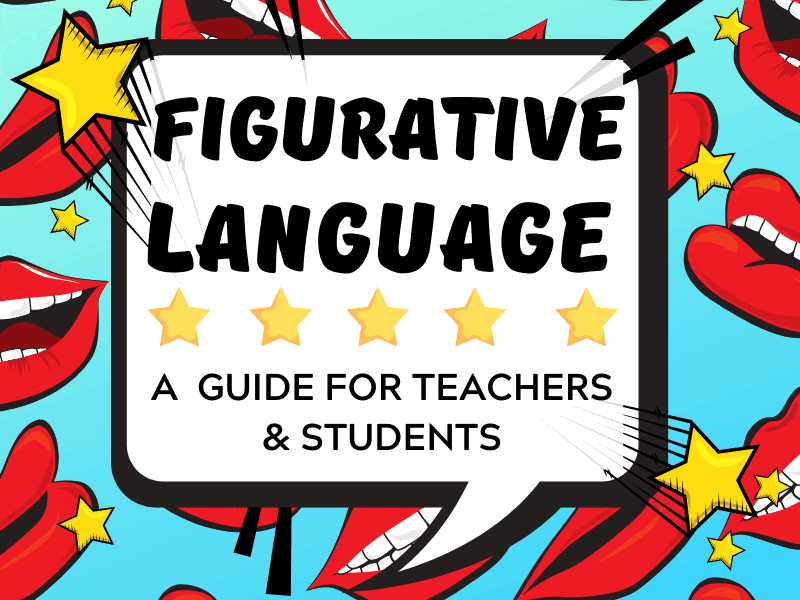
WHAT ARE LITERARY DEVICES?
If words are the raw materials of a writer’s trade, literary devices are the tools the writer uses to craft those words into a meaningful and/or beautiful shape.
Hundreds of these devices are at a writer’s disposal, covering every aspect of the writing process from word and sentence level (figurative language techniques) to whole-text level (structural techniques).
As we already have A Complete Guide to Figurative Language, we’ll concentrate on literary devices other than the figurative language in this article.
First, we’ll define each term, then provide an example or two of it before finally giving a simple activity you can use with your students to help them consolidate their understanding of each device.
In this article, we’ll take a look at the following devices in turn:
- Allegory
- Allusion
- Flashback
- Foreshadowing
- Imagery
- Irony
- Juxtaposition
- Point-of-view
- Satire
- Symbol
COMMON LITERARY DEVICES
These are the types of literary devices you can easily fit into a broad range of writing styles once understood.
ALLEGORY
ALLEGORY DEFINITION: WHAT IS ALLEGORY?
An allegory is when the characters and events of a story are used to convey a deeper hidden meaning, often either moral or political.
Writing an allegory involves climbing down the ladder of abstraction to bring clarity to abstract ideas by tying them to the characters and events of a story.
Allegories are often used to express controversial or even dangerous opinions as they allow the writer to create some distance between themselves and the ideas being discussed.
Allegories use people/animals, places, and events as symbols of other people or ideas.
Unsurprisingly, we commonly see this device used in political, philosophical, or religious contexts.
ALLEGORY EXAMPLES:
At face value, George Orwell’s Animal Farm is a straightforward fable with animals as the main characters. Scratching beneath the surface reveals it is also a searing critique of Russian communism in the 20th century.
As mentioned, there are two layers in an allegory. The story serves as the upper layer, and a deeper layer below represents the more profound meaning.
Aesop’s fables also provide well-known examples of allegory.
ALLEGORY TEACHING ACTIVITIES:
Ask students about some of Aesop’s well-known stories (The Hare and the Tortoise, The Lion and the Mouse, etc.). Can they retell the stories briefly?
Now, ask the students to discuss in smaller groups what they think the hidden meaning of each fable is.
ALLUSION
ALLUSION DEFINITION: WHAT IS ALLUSION?
An allusion is when the writer refers to the events or characters from another story. This is done to provide context or give depth.
Because the success of this device depends on the reader’s familiarity with the text referred to, allusions are usually made to the most widely known texts, which, in the case of English, include the Bible and the poems and plays of William Shakespeare.
ALLUSION EXAMPLES:
While allusions are prevalent in works of literature, we also see them used widely in our everyday speech and the broader world around us.
Advertisements are a particularly rich source of everyday allusions. For example, the logo of Starbucks alludes to the siren of Greek mythology. Likewise, Nike alludes to the Greek goddess of victory.
ALLUSION TEACHING ACTIVITIES:
In this activity, tell students they’re going to hunt the allusions. Challenge students to list all the allusions they come across over a period of a week. These allusions may appear in speech, print, or any form of popular culture. Students can share and discuss their findings at the end of the week.
FLASHBACK
FLASHBACK DEFINITION: WHAT IS A FLASHBACK?
In a flashback, the writer reveals to the reader something that happened before the present moment in the narration.
Flashbacks are often used to bring context to current events in a story. This structural device can allow the writer to withhold pertinent pieces of information from the reader (or viewer) to reveal at suitably dramatic moments, thereby increasing the impact of the narrative.
FLASHBACK EXAMPLES:
Flashbacks are particularly common in movies. A fantastic example of flashbacks being used to great effect is in the movie The Usual Suspects, where most of the story is told by Kevin Spacey’s character in the form of flashbacks until the final scene of the movie reveals him to be the dark force that is Keyser Söze.
FORESHADOWING
FORESHADOWING DEFINITION: WHAT IS FORESHADOWING?
While the flashback looks backward, foreshadowing hints at things yet to come in a story.
Foreshadowing can create anticipation and expectation in a story. It can create a suspenseful atmosphere and motivate the reader to continue reading to discover what happens.
FORESHADOWING EXAMPLES:
There are many fine examples of foreshadowing in John Steinbeck’s masterful short novel Of Mice and Men.
For example, early in the story, George scolds Lenny for keeping a dead mouse in his pocket. He reminds him that when he used to keep mice to pet them, he always accidentally killed them when he stroked them. This incident foreshadows Lenny’s killing of Curley’s wife later in the story.
FORESHADOWING ACTIVITIES:
One of the most common types of foreshadowing is known as Chekhov’s Gun and comes from the famous playwright’s oft-quoted writing advice:
“If in the first act you have hung a pistol on the wall, then in the following one, it should be fired. Otherwise, don’t put it there.”
In this practice activity, organize your students into groups and instruct them to write down the endings of 3 stories they are familiar with – books or movies.
Now, in their groups, challenge them to create an introduction scene to the book or movie that contains a Chekhov’s Gun-type foreshadowing of the ending.
IRONY
IRONY DEFINITION: WHAT IS IRONY?
There are three main types of irony:
- Dramatic irony – when the reader has more knowledge than the character
- Situational irony – where there is a contrast between expectations and reality
- Verbal irony – when there is an incongruity between the superficial meaning of a thing said and what is actually meant.
IRONY EXAMPLES:
We can see many examples of verbal irony in George Orwell’s seminal novel 1984, where The Party espouses slogans such as “War is peace. Freedom is slavery. Ignorance is strength.”
In The Lion King, the audience knows that Scar is responsible for Mufasa’s death, while Simba thinks he himself is to blame. This is an example of dramatic irony.
We can find an example of situational irony in the movie The Sixth Sense when we discover that the child Cole, who sees dead people, is himself dead.
IRONY TEACHING ACTIVITIES:
An excellent activity to help students understand the different types of irony is organising them into groups and challenging them to create their own ironic scenarios. Students should write these scenarios down. They can then pass them to another group, who must identify the type of irony being demonstrated in each scenario.
JUXTAPOSITION
JUXTAPOSITION DEFINITION: WHAT IS JUXTAPOSITION?
Juxtaposition involves placing two ideas, characters, places, or events side by side to encourage the reader to compare and contrast them. Most often, it’s used to highlight the difference between the two things, but sometimes it’s used to imply a link between two things we wouldn’t ordinarily connect.
JUXTAPOSITION EXAMPLES:
One of the best-known examples of juxtaposition used in literature can be found at the opening of Charles Dickens’s novel A Tale of Two Cities:
“It was the best of times, it was the worst of times, it was the age of wisdom, it was the age of foolishness, it was the epoch of belief, it was the epoch of incredulity, it was the season of Light, it was the season of Darkness….”
In this extract, we can see Dickens juxtaposing many opposites, foreshadowing the conflict and contradictions that lie at the heart of his novel.
JUXTAPOSITION TEACHING ACTIVITIES:
We can find many examples of juxtaposition in our everyday speech. For example, when people realize that they hold differing views and that further debate is futile, they might say, “We’ll agree to disagree”.
We might also compose our own examples. For example, we might write, “She had high hopes for their future together, but her dark past haunted her still.”
Organize students into groups and challenge them to find and list as many examples of juxtaposition as possible and list them. They can organize their examples into three categories:
- Examples from literature
- Examples from everyday speech
- Examples the students compose themselves.
Encourage students to share their work when they’ve finished.
POINT-OF-VIEW
POINT OF VIEW DEFINITION: WHAT IS POINT-OF-VIEW?
Point-of-view (POV) is the perspective from which a story is told. A student can identify a story’s POV by answering the question: Who is telling this story? We have a complete guide to point-of-view here, but here are the need-to-know facts below.
There are many possible POVs from which to tell a story. Some of the main ones are:
- First-person – the story is told from the main character’s point (I, we, our, etc.)
- Second person – the narrator speaks directly to the reader (you)
- Third-person – an external narrator tells the story (he, she, they, etc.).
There are many variations on POV, too, and for students to gain a good grasp on this device will take lots of explicit teaching and practice.
POINT OF VIEW EXAMPLES:
- First-person – “I awoke early that morning to the sound of a car backfiring in the street below.”
- Second person – “You awake early in the morning to the sound of a car backfiring in the street below.”
- Third-person – “She awoke early that morning to the sound of a car backfiring in the street below.”
POINT OF VIEW ACTIVITY:
A simple way for students to practice identifying and writing from different POV is to take a passage from a book, identify the POV being used, and then rewrite it from a variety of different POVs.
SATIRE
SATIRE DEFINITION: WHAT IS SATIRE?
The term ‘satire’ can refer to a distinct literary genre and a literary device. Here, we’ll concern ourselves exclusively with the device.
Satire is the skilful use of humor to mock or ridicule a person, an idea, or an institution by exposing or criticizing it. It’s often used in conjunction with other literary devices, such as irony and juxtaposition. Its purpose isn’t just to entertain but to inform; sometimes, it can contain a call to action.
SATIRE EXAMPLES:
Ambrose Bierce’s satirical dictionary, The Devil’s Dictionary, contains some great examples of satire in its definitions. Here are some examples from it:
Advice, n. The smallest current coin.
Consul, n. In American politics, a person who has failed to secure an office from the people is given one by the Administration on the condition that he leave the country.
Telephone, n. An invention of the devil which abrogates some of the advantages of making a disagreeable person keep his distance.
SATIRE TEACHING ACTIVITY:
Read through some more examples of Ambrose Bierce’s satirical definitions; the Devil’s Dictionary is freely available online. Then, task the students with devising some satirical definitions for commonplace words you list on the board. The words birthday, graduation, and marriage might be an excellent place to start.
SYMBOLISM
SYMBOLISM DEFINITION: WHAT IS SYMBOLISM?
When a writer uses symbolism in their work, they’re ascribing meanings to objects beyond that of their original functions or literal meanings. The use of symbolism in literature adds layers of meaning to work, allowing for it to be read at different levels by the reader. Symbolism can be developed in a work through the use of other literary devices, particularly figurative speech devices such as metaphor and simile.
SYMBOLISM EXAMPLES:
The same symbols can have different meanings in different contexts. The swastika is a good example of this. While in Hinduism, this symbol represents life and good luck, it meant something entirely different in Nazi Germany.
If we return to John Steinbeck’s Of Mice and Men, we can see Candy’s dog being used to symbolize the fate of the weak in a harsh environment.
SYMBOLISM TEACHING ACTIVITY:
Students need to learn to understand that symbols use one thing to stand for another.
For this game, divide the class into small groups and provide each with a different list of nouns.
The students should then work in groups to create a visual ‘symbol’ for each of the nouns on their list.
For example, if a group works on the word school, they might draw a pencil-shaped building with children peeping out the windows.
You can easily differentiate this activity by altering the difficulty level of the words used. For example, you might use more abstract nouns such as jealousy for more advanced students.
TIPS FOR INCORPORATING LITERARY DEVICES INTO YOUR WRITING
Incorporating literary devices into your writing will add depth and complexity to your essays and narratives, making them more interesting and engaging for your audience. Here are some top tips to add literary devices to your writing.
TO WRAP UP
The above is not an exhaustive list of structural literary devices, but they represent our students’ most common and useful ones to focus on.
If our students understand both the literary devices here and those in our accompanying article on figurative language, they’ll be able to competently interpret their use in the work of others, as well as be able to employ them in their own writing.
OTHER ARTICLES RELATED TO LITERARY DEVICES







